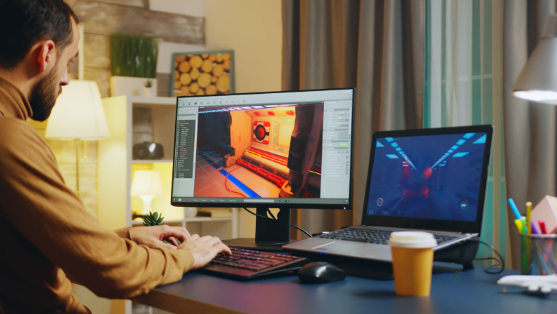When you think about mobile games that truly stick—the ones you find yourself returning to even after weeks or months—it’s never just about the graphics or even the storyline. It’s about retention. Retention is the golden metric of modern mobile gaming. It’s what separates a quick download-and-delete experience from a long-term, loyal player base. And behind this elusive magic lies the combined effort of two forces: a mobile game development company and a game design studio working in sync.
Why Retention Is More Critical Than Ever
In today’s saturated app stores, where thousands of games launch every month, getting noticed is already a challenge. But even harder is keeping players engaged after the first play session. Studies show that around 70% of users churn within the first 24 hours of downloading a mobile game. That’s a staggering figure—and one that makes retention not just a design concern but a survival strategy.
Retention isn’t about tricking players into staying longer. It’s about designing experiences that are worth coming back to. And that’s where thoughtful collaboration comes in.
The Role of Game Design Studios: Building the Core Experience
A game design studio is often the birthplace of player-centric creativity. Their role extends far beyond aesthetics. They are responsible for crafting the user journey, the moment-to-moment gameplay loops, and the emotional beats that drive satisfaction.
- Onboarding as the First Hook: A design studio knows the power of first impressions. A smooth, intuitive onboarding process helps players feel competent from the start. Tutorials need to be subtle, interactive, and non-intrusive—so the player feels guided, not lectured.
- Balancing Difficulty Curves: Too easy, and players get bored. Too hard, and they get frustrated. Game design studios analyze pacing to ensure each level challenges just enough to trigger a sense of achievement without alienating players.
- Reward Systems That Feel Earned: Whether it’s unlocking a new character, receiving virtual currency, or simply beating a tough level, rewards must be meaningful. A studio focuses on weaving in rewards that align with player effort, reinforcing a sense of progression.
The Role of Mobile Game Development Companies: Making It Scalable and Sticky
On the other side of the equation, the development company takes these ideas and transforms them into playable, scalable realities. This is where technology meets psychology.
- Analytics and Iteration: A mobile game development company integrates data-driven insights into design. They can track player behaviors, see where drop-offs occur, and fine-tune the experience accordingly. Retention is rarely “set and forget”; it’s an ongoing process.
- Seamless Performance Across Devices: No matter how brilliant the design, poor performance kills retention. Development teams ensure smooth gameplay across a fragmented device ecosystem, minimizing crashes and latency issues that frustrate users.
- Social and Multiplayer Features: Players are more likely to stay when games offer community-driven elements—leaderboards, co-op missions, or PvP battles. Development companies bring these features to life with robust backend systems.
The Symbiosis: Where Design Meets Development
Retention emerges strongest when design studios and development companies collaborate closely. A brilliant design idea without technical feasibility remains a sketch; equally, robust coding without a compelling design leaves the experience hollow.
Consider the wildly successful puzzle or RPG titles on mobile markets today. Their retention doesn’t come solely from eye-catching visuals or smooth performance but from the fusion of narrative, gameplay loops, and technical polish. For example:
- A designer proposes a reward system tied to daily logins.
- The development team ensures notifications are personalized, non-intrusive, and timed around user activity patterns.
- Together, they test, iterate, and adjust until the mechanic feels natural rather than forced.
This back-and-forth builds the kind of invisible polish that players can’t articulate but can feel.
Retention Strategies That Work Today
So, what are some proven strategies in 2025 that embody this collaboration?
- LiveOps Integration – Beyond static launches, games now evolve through regular events, seasonal content, and time-limited challenges. Designers shape the theme; developers implement scalable event systems.
- Personalization at Scale – Analytics-driven personalization ensures no two players feel exactly the same journey. One might get difficulty adjustments, another custom rewards. It’s the union of behavioral psychology and coding precision.
- Cross-Platform Progression – With users shifting between phones, tablets, and even PCs, enabling progress sync ensures continuity. It’s a retention driver that blends technical expertise with user-centric design thinking.
- Community-First Features – Chat systems, guild mechanics, and co-op events don’t just retain players—they transform them into advocates. Designers envision the mechanics, while developers ensure stability under global player loads.
The Human Side of Retention
At its core, retention is about respect: respecting the player’s time, effort, and need for meaningful engagement. When a mobile game delivers genuine joy and challenge, players reward it with loyalty. It’s less about “keeping users hooked” and more about “earning their return.”
And this is why the partnership between a mobile game development company and a game design studio matters. One brings the creativity of crafting unforgettable experiences; the other ensures those ideas thrive in the hands of millions of players worldwide.
Closing Thoughts
As the mobile gaming landscape becomes more competitive, designing for retention isn’t just good practice—it’s existential. The games that will dominate the future aren’t the ones that attract the most downloads on launch day, but the ones players can’t stop returning to.
And that magic lies in collaboration—when design and development aren’t silos but partners. Together, they don’t just build games; they build lasting player relationships.
